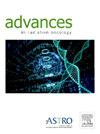描述种族和当代红线对老年乳腺癌妇女接受指南一致的局部治疗的影响。
IF 2.2
Q3 ONCOLOGY
引用次数: 0
摘要
目的:改善乳腺癌(BC)的局部控制可提高总生存率。在老年患者中,当代红线与较差的BC生存率相关。自我报告的种族与生存、边缘化和获得护理有关。我们的目的是研究种族、红线和接受指南一致的局部区域治疗(LRT)对老年女性BC之间的关系。方法和材料:在监测、流行病学和最终结果-医疗保险中确定2010年至2017年诊断为I至III期BC的66岁至90岁女性。红线是根据《住房抵押贷款披露法》的数据估计的。根据接受手术和适当的辅助放射治疗来评估符合指南的LRT。考虑协变量,拟合逻辑回归模型来检验红线与接受指南一致性LRT之间的关系。使用了msa级别的集群引导。结果:该队列包括64,987名女性:31%的年龄在66岁至70岁之间,82%的非西班牙裔(NH)白人,12%的双重医疗补助/医疗保险登记。94%的患者接受了手术切除;84%的患者接受了符合指南的LRT。与NH白人相比,NH黑人与较低的指南一致性LRT相关(优势比[OR], 0.78;95% ci, 0.71-0.84)。在NH白人和NH亚洲或西班牙裔妇女之间没有显著差异。与低红线地区相比,居住在高红线地区接受符合指南的轻轨治疗的几率较低(OR, 0.89;95% ci, 0.82-0.95, p = .002)。结论:在这组患有BC、NH的老年妇女中,即使在调整了几个重要的临床和人口统计学因素后,黑人和红线仍与接受符合指南的LRT的可能性较低相关。这一发现表明人际种族主义和歧视对接受癌症定向治疗的深远影响,并强调需要进一步努力打击系统性不平等和人际种族主义。本文章由计算机程序翻译,如有差异,请以英文原文为准。
Characterizing the Impact of Race and Contemporary Redlining on Receipt of Guideline-Concordant Locoregional Therapy Among Older Women With Breast Cancer
Purpose
Improving locoregional control for breast cancer (BC) results in better overall survival. Contemporary redlining is associated with worse BC survival in older patients. Self-reported race is associated with survival, redlining, and access to care. We aim to examine the relationship between race, redlining, and the receipt of guideline-concordant locoregional therapy (LRT) in older women with BC.
Methods and Materials
Women aged 66 to 90 years with stage I to III BC diagnosed in 2010 to 2017 with known metropolitan statistical area were identified in Surveillance, Epidemiology, and End Results-Medicare. Redlining was estimated using Home Mortgage Disclosure Act data. Guideline-concordant LRT was assessed based on receipt of surgery and appropriate adjuvant radiation treatment. A logistic regression model was fitted to examine the relationship between redlining and receipt of guideline-concordant LRT, accounting for covariates. Cluster bootstrap at the MSA-level was used.
Results
The cohort included 64,987 women: 31% aged 66 to 70, 82% non-Hispanic (NH) White, 12% with dual Medicaid/Medicare enrollment. Ninety-four percent underwent surgical resection; 84% received guideline compliant LRT. NH Black race was associated with lower receipt of guideline-concordant LRT compared to NH White (odds ratio [OR], 0.78; 95% CI, 0.71-0.84). No significant differences were noted between NH White and NH Asian or Hispanic women. Residing in high-redlining areas was associated with lower odds of receiving guideline-concordant LRT compared to low-redlining areas (OR, 0.89; 95% CI, 0.82-0.95, P = .002).
Conclusions
In this cohort of older women with BC, NH Black race and redlining, even after adjusting for several important clinical and demographic factors, were associated with a lower likelihood of receiving guideline-concordant LRT. This finding demonstrates the profound impact of interpersonal racism and redlining on receipt of cancer-directed therapies and highlights the need for further work to combat systemic inequities and interpersonal racism.
求助全文
通过发布文献求助,成功后即可免费获取论文全文。
去求助
来源期刊

Advances in Radiation Oncology
Medicine-Radiology, Nuclear Medicine and Imaging
CiteScore
4.60
自引率
4.30%
发文量
208
审稿时长
98 days
期刊介绍:
The purpose of Advances is to provide information for clinicians who use radiation therapy by publishing: Clinical trial reports and reanalyses. Basic science original reports. Manuscripts examining health services research, comparative and cost effectiveness research, and systematic reviews. Case reports documenting unusual problems and solutions. High quality multi and single institutional series, as well as other novel retrospective hypothesis generating series. Timely critical reviews on important topics in radiation oncology, such as side effects. Articles reporting the natural history of disease and patterns of failure, particularly as they relate to treatment volume delineation. Articles on safety and quality in radiation therapy. Essays on clinical experience. Articles on practice transformation in radiation oncology, in particular: Aspects of health policy that may impact the future practice of radiation oncology. How information technology, such as data analytics and systems innovations, will change radiation oncology practice. Articles on imaging as they relate to radiation therapy treatment.
 求助内容:
求助内容: 应助结果提醒方式:
应助结果提醒方式:


